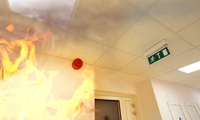

A manifesto for fire safety has been produced by the British Woodworking Federation (BWF) Certifire fire door and doorset scheme, calling upon government to significantly improve the level of fire protection for building users within UK legislation.
The manifesto focuses on four key areas: educating and promoting the awareness of the importance of fire doors, ensuring that building regulations are updated to emphasise safe practice, stamping out inadequate products, and ensuring that those responsible for building fire safety are held accountable.
In particular, BWF Certifire is calling for a new national register of ‘responsible persons’ as part of a package of actions to clarify the Regulatory Reform (Fire Safety) Order 2005.
Building owners have a legal duty to comply with the Fire Safety Order. Under the law in England and Wales, they must appoint a 'responsible person'. The same person is called the ‘duty holder’ under Scottish law, and the regulations in Northern Ireland refer to the ‘appropriate person’. Their duties are all the same: to carry out the fire risk assessment and ensure the safety of anyone using their premises.
The result of common confusion about this role is particularly poignant given the case of Sophie Rosser who died in a building fire in 2012. To this day, no prosecutions have been brought and the coroner was frustrated in her attempts to identify who was responsible for fire door maintenance in the building where Ms Rosser died.
David Oldfield, head of joinery at Arnold Laver and chairman of the BWF Certifire scheme, said: “Greater clarity around the role of the responsible person is critical. We’re calling on government to make it much more visible who is responsible for fire door specification, procurement, installation, maintenance, inspection and documentation. Only then can we get accountability, and achieve the behaviour change that will make our buildings safer.”
The BWF Certifire manifesto also highlights the continued confusion around Regulation 38 of the Building Regulations in England and Wales. This regulation requires fire safety information to be given to the responsible person, but it is often overlooked and is difficult to assess for compliance.
The regulation is particularly important to tighten up, says BWF Certifire, as 45% of those responsible for fire safety in their organisation say that they do not know how to spot a dodgy fire door despite their legal obligation of ensuring that a building is safe to use.
Mr Oldfield said: “It also seems crazy that building control consent is effectively granted before full compliance with Regulation 38 is confirmed and documented. We want to see support for a review and improvement of fire safety in building regulations overall, across all countries of the UK, with more emphasis on door safety and compartmentation particularly in hospitals, care homes and other buildings that may house vulnerable residents or have a ‘stay put’ fire plan.”
The manifesto reminds policy makers that, in a research report by the Zero Carbon Hub, 100% of new home sites were found to suffer from inadequate product substitution. This is also known to happen in a wide range of non-domestic buildings.
However, Approved Document B, the guidance on fire safety in Building Regulations and England and Wales, currently falls short of requiring third-party certification and allows fire safety products to be installed without adequate proof of performance or compliant installation.
“Serious consideration should be given to enshrining third-party certification for fire doors and other passive fire protection products into regulation. It is crucial to limit the opportunity for substitution of untested and dangerous products. We can do this through tougher regulation, better guidance and effective building control,” said Mr Oldfield.
Finally, BWF Certifire is calling for fire door training to be included in formal qualifications and competency frameworks within the construction industry, and for continued government support for Fire Door Safety Week which runs for the fourth year in September 2016.
You can see the full manifesto on the BWF Certifire website.